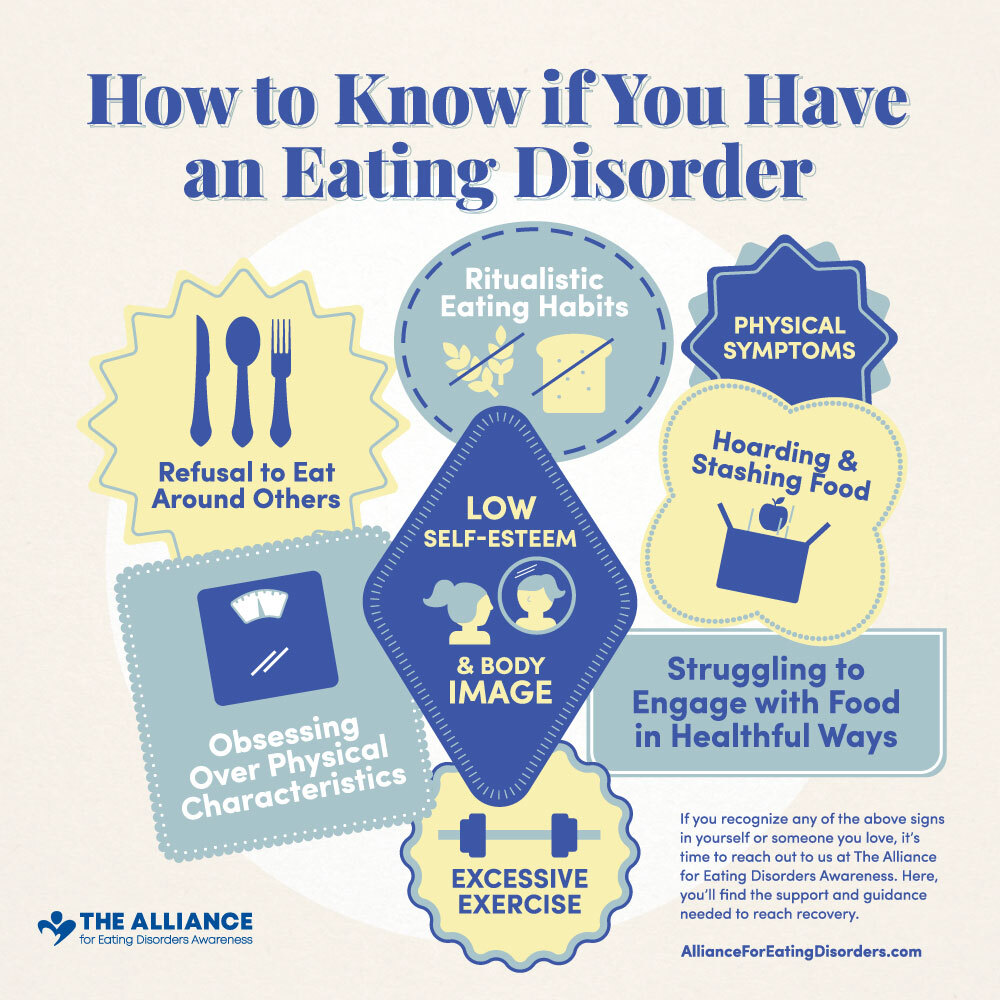How do we know when disordered eating becomes an eating disorder? Disordered eating does not interfere with one’s ability to function, but may include irregular eating patterns along with judgment around food and/or body. Eating disorders, on the other hand, represent a wide range of behaviors involving food and eating and impair one’s health and ability to function in terms of life goals, relationships, career, and academics. It may be hard to determine whether or not you are experiencing disordered eating or an eating disorder.
First, it may be helpful to reflect on the following questions:
- What are the signs of an eating disorder?
- Are you displaying these signs?
For many individuals with eating disorders, here are some of the more commonly experienced signs and behaviors:
1. Adopting Ritualistic Eating Habits and Rules
Eating a set quantity of a particular food at a certain time in a certain setting may be part of a daily routine. However, when taken to extremes that interfere with everyday life, ritualistic habits and rigid rules may indicate an unhealthy relationship with food. Eliminating whole food groups, limiting food intake, restricting quantities or following inflexible preparation practices may be a sign of an eating disorder.
2. Refusing to Eat With Others
Handling food in social settings can be challenging for those struggling with eating disorders. Individuals may go to great lengths to avoid group events where food is present. They may disengage and disappear from a gathering when food is served.
3. Struggling to Engage with Food in Healthful Ways
Individuals with eating disorders may exhibit unhealthful relationships with food, including avoiding and/or restricting food, purging, and/or eating past the point of fullness. Stress, boredom, grief, joy or other emotions may trigger or intensify eating disordered behaviors.
4. Exercising Excessively to Burn Calories
With an eating disorder, exercise can become more than a means of joyful or healthful movement. Instead, it may become a way to compensate for caloric intake or as a way to punish themselves for “eating too much.” People with eating disorders often become obsessive about tracking the number of calories expended versus the number of those taken in.
5. Obsessing Over Physical Characteristics
Many individuals with eating disorders tend to focus on perceived body image concerns that may or may not be apparent to others. They may obsess over specific parts of their bodies or set weight/size goals that are unhealthy or unrealistic.
6. Hoarding and Stashing Food
Eating disorders can cause people to hide or stash food. In some cases, individuals may hoard select “safe” foods or beverages. They may feel the need to stockpile it, keep it separate or even hide it, so that other family members can’t eat it. For others, the hidden food in question may be triggering to the person, and they may view it as forbidden.
7. Lowered Self-Esteem
Low self-esteem is commonly experienced by those struggling with eating disorders. This can manifest through insecurities over physical characteristics, such as body shape and weight, as well as a generally lowered self-worth – feeling as though you are not worthy or do not measure up to your peers in some way. Oftentimes, disordered eating behaviors are developed as a way to cope with feelings of inadequacy and take back some level of perceived “control” over their life.
8. Physical Symptoms
There are many physical symptoms associated with eating disorders, oftentimes varying depending on the specific type of eating disorder. Physical symptoms may include gastrointestinal problems, fatigue, high or low blood pressure or fluctuations in weight over relatively short periods of time. Individuals may also experience weakness, dizziness, joint pain or dehydration. For a more detailed breakdown of physical symptoms for each type of eating disorder, visit our pages on Anorexia Nervosa, Bulimia Nervosa, Binge Eating Disorder, ARFID and OSFED.
When to Take the Next Step
If you recognize any of the above signs in yourself or in someone you love, it may be time to reach out to us at the National Alliance for Eating Disorders. Here, you’ll find the support and guidance needed to help on the journey to recovery.
To learn more about the eating disorder treatment process, visit our Levels of Care page, which highlights the different types of care one may need. If you’re ready to take the next step in receiving help or support for an eating disorder, visit our national, interactive database to find a provider near you or call us at 866.662.1235 to speak with a specialized and licensed therapist. You are not alone. Help is available and recovery is possible.

